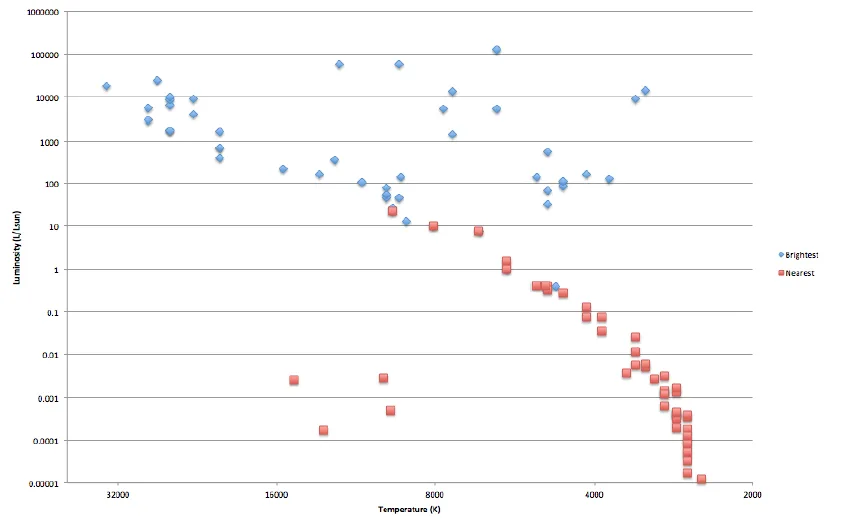Very few stars appear in both groups. However, the number of these stars is very scarce, and the overlap, as observed by the HR diagram, is also very limited. The majority of the stars fall into their own respective groups, i.e., they are either converted into Red Giants or end up as White Dwarfs and Black Holes. Therefore, it can also be said that the few stars falling in both groups or in overlapping regions are a few exceptions only.
What are the brightest and dimmest luminosity stars in each group? What are the highest and lowest temperature stars in each group? And what are the largest and smallest radius stars in each group? If you highlight the whole table, you can sort by each column to easily find the largest and smallest values. (Otherwise, you will need to figure it out by looking down the list.)
The Red Giant stars are the brightest, while the White dwarfs, along with some stars on the main sequence line, are the dimmest stars in each group.
Sirius B is the brightest white star, while Canopus is the brightest and hottest Red Giant. Bernards Star is the dimmest star on the HR diagram. In the HR Diagram, the star with the highest temperature has 40,000K of temperature, while the lowest is 2500K (Bernard’s Star).
Copy and paste your completed HR Diagram.
How do the nearest and brightest stars compare? Does this agree with your hypothesis from the Pre-lab Assignment?
The nearest stars have cooler temperatures. They also have dimmer luminosity, and their size is considerably smaller. Also, the colour of the nearest stars is red. However, in the case of the brightest stars, they are hotter in temperature. Their luminosity is also higher, i.e. they are brighter and larger in size. Their colour is also bluer.
This finding clearly agrees with the hypothesis for the pre-lab assignment as it confirms the general properties of the two categories of stars.
How can the differences between the nearest and brightest stars be explained? Furthermore, if we presume that the Sun is not in a particularly unique part of the galaxy, what do your results tell you about the relative numbers of very bright and very dim stars?
The nearest stars are located at the bottom of the HR diagram, while the brightest stars are located at the top of the diagram. The brightest stars include Blue Giants and White dwarfs, while the cooler stars include red giants as well as some main sequence stars. It is the distance and direction travelled by the star on the graph that determines its category and the nearest or the brightest location. Furthermore, the presumed number of hottest and collect stars appear to be more or less equivalent according to the generated HR Diagram – ignoring the position of the sun.
References
Schwarzschild, M. (2015). Structure and evolution of stars. Princeton University Press.
Portegies Zwart, S. F., McMillan, S. L., Hut, P., & Makino, J. (2001). Star cluster ecology—IV. Dissection of an open star cluster: photometry. Monthly Notices of the Royal Astronomical Society, 321(2), 199-226.
Cite This Work
To export a reference to this article please select a referencing stye below:








